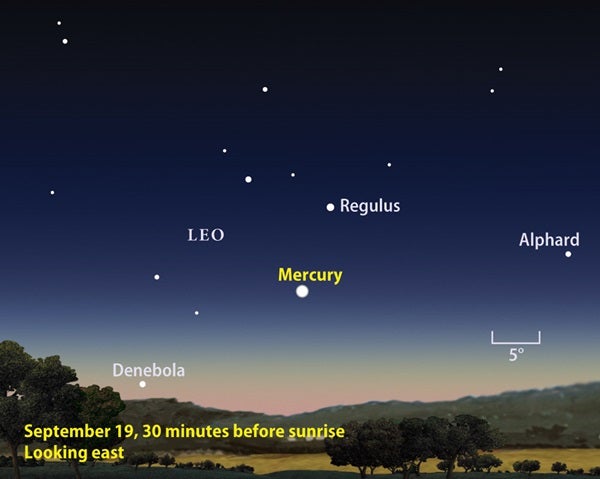Mercury’s close proximity to the Sun makes the planet difficult to spot. This is because our star’s glare washes out the bright point of light. In addition, the innermost planet never gets far enough from the Sun to appear high in a totally dark sky. But in mid-September at dawn, look about 18° west of the Sun to find this elusive planet. (The width of your first held at arm’s length equals approximately 10°.) September 19 marks the best time in 2010 to see Mercury in the morning. It reaches greatest western elongation, meaning the innermost planet attains its greatest angle away from the Sun as seen from Earth.
On September, 13 Mercury lies 6° below Regulus, the bright blue star in Leo the Lion. The planet shines at 1st magnitude, a bight brighter than Leo’s luminary. You probably will have to use binoculars or a small telescope to view it on the 13th.
But, by the 19th, Mercury brightens to magnitude -0.4 and shows a half-illuminated disk. Make sure to head outside about an hour before sunrise so you have time to get your bearings. That’s when the planet rises in the east-northeast. According to Astronomy magazine Senior Editor Richard Talcott, “If you don’t see Mercury right away, try finding it through binoculars. Once you know where it is, Mercury will pop into view.” Once you spot it, see how long you can keep the planet in sight as the sky brightens.
Mercury will still be visible through the end of the month if you have an unobstructed eastern horizon. On the 30th, the innermost planet glows at magnitude -1.1 but will be much closer to the horizon.
The next good opportunity to view Mercury will be in the winter. So head out in the pleasant autumn pre-dawn hours to glimpse the innermost planet.
- Mercury orbits the Sun at an average distance of 36 million miles (58 million kilomters), but covers a broad range from 29 million miles to 44 million miles (47 million km to 71 million km).
- Mercury takes just 88 days to complete one orbit of the Sun.
- Mercury takes 59 days to rotate once on its axis.
- With a diameter of 3,032 miles (4,880 km, or 38 percent of Earth’s), Mercury is the smallest planet in the solar system.
- Humans got their first close-up look at Mercury in March 1974 when NASA’s Mariner 10 spacecraft flew by and revealed a heavily cratered surface.
- NASA launched the MESSENGER spacecraft toward Mercury in August 2004. It will go into orbit around the innermost planet about 6 months from now (in March 2011), examining the planet’s surface, probing its interior, and measuring its magnetic field.
- StarDome: Locate Mercury in your morning sky with our interactive star chart.
- Sign up for our free weekly e-mail newsletter.











